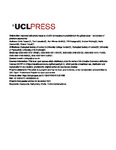Improved bathymetry leads to >4000 new seamount predictions in the global ocean – but beware of phantom seamounts!
| dc.contributor.author | Yesson, C | |
| dc.contributor.author | Letessier, TB | |
| dc.contributor.author | Nimmo-Smith, Alex | |
| dc.contributor.author | Hosegood, Philip | |
| dc.contributor.author | Brierley, AS | |
| dc.contributor.author | Hardouin, M | |
| dc.contributor.author | Proud, R | |
| dc.date.accessioned | 2022-01-05T16:30:37Z | |
| dc.date.available | 2022-01-05T16:30:37Z | |
| dc.date.issued | 2021-12-22 | |
| dc.identifier.issn | 2632-0886 | |
| dc.identifier.issn | 2632-0886 | |
| dc.identifier.uri | http://hdl.handle.net/10026.1/18532 | |
| dc.description.abstract |
<jats:p>Seamounts are important marine habitats that are hotspots of species diversity. Relatively shallow peaks, increased productivity and offshore locations make seamounts vulnerable to human impact and difficult to protect. Present estimates of seamount numbers vary from anywhere between 10,000 to more than 60,000. Seamount locations can be estimated by extracting large, cone-like features from bathymetry grids (based on criteria of size and shape). These predicted seamounts are a useful reference for marine researchers and can help direct exploratory surveys. However, these predictions are dependent on the quality of the surveys underpinning the bathymetry. Historically, quality has been patchy, but is improving as mapping efforts step up towards the target of complete seabed coverage by 2030. This study presents an update of seamount predictions based on SRTM30 PLUS global bathymetry version 11 and examines a potential source of error in these predictions. This update was prompted by a seamount survey in the British Indian Ocean Territory in 2016, where locations of two putative seamounts were visited. These ‘seamounts’ were targeted based on previous predictions, but these features were not detected during echosounder surveys. An examination of UK hydrographic office navigational (Admiralty) charts for the area showed that the summits of these putative features had soundings reporting ‘no bottom detected at this depth’ where ‘this depth’ was similar to the seabed reported from the bathymetry grids: we suspect that these features likely resulted from an initial misreading of the charts. We show that 15 ‘phantom seamount’ features, derived from a misinterpretation of no bottom sounding data, persist in current global bathymetry grids and updated seamount predictions. Overall, we predict 37,889 seamounts, an increase of 4437 from the previous predictions derived from an older global bathymetry grid (SRTM30 PLUS v6). This increase is due to greater detail in newer bathymetry grids as acoustic mapping of the seabed expands. The new seamount predictions are available at <jats:ext-link xmlns:xlink="http://www.w3.org/1999/xlink" ext-link-type="uri" xlink:href="https://doi.pangaea.de/10.1594/PANGAEA.921688">https://doi.pangaea.de/10.1594/PANGAEA.921688</jats:ext-link>.</jats:p> | |
| dc.format.extent | e030- | |
| dc.format.medium | Electronic-eCollection | |
| dc.language | en | |
| dc.language.iso | en | |
| dc.publisher | UCL Press | |
| dc.subject | bathymetry | |
| dc.subject | environmental science | |
| dc.subject | knolls | |
| dc.subject | seamounts | |
| dc.title | Improved bathymetry leads to >4000 new seamount predictions in the global ocean – but beware of phantom seamounts! | |
| dc.type | journal-article | |
| dc.type | Journal Article | |
| plymouth.author-url | https://www.ncbi.nlm.nih.gov/pubmed/37228795 | |
| plymouth.volume | 4 | |
| plymouth.publication-status | Published online | |
| plymouth.journal | UCL Open: Environment | |
| dc.identifier.doi | 10.14324/111.444/ucloe.000030 | |
| plymouth.organisational-group | /Plymouth | |
| plymouth.organisational-group | /Plymouth/Faculty of Science and Engineering | |
| plymouth.organisational-group | /Plymouth/Faculty of Science and Engineering/School of Biological and Marine Sciences | |
| plymouth.organisational-group | /Plymouth/PRIMaRE Publications | |
| plymouth.organisational-group | /Plymouth/REF 2021 Researchers by UoA | |
| plymouth.organisational-group | /Plymouth/REF 2021 Researchers by UoA/UoA07 Earth Systems and Environmental Sciences | |
| plymouth.organisational-group | /Plymouth/Research Groups | |
| plymouth.organisational-group | /Plymouth/Research Groups/Marine Institute | |
| plymouth.organisational-group | /Plymouth/Users by role | |
| plymouth.organisational-group | /Plymouth/Users by role/Academics | |
| plymouth.organisational-group | /Plymouth/Users by role/Researchers in ResearchFish submission | |
| dc.publisher.place | England | |
| dcterms.dateAccepted | 2021-11-03 | |
| dc.rights.embargodate | 2022-1-7 | |
| dc.identifier.eissn | 2632-0886 | |
| dc.rights.embargoperiod | Not known | |
| rioxxterms.versionofrecord | 10.14324/111.444/ucloe.000030 | |
| rioxxterms.licenseref.uri | http://www.rioxx.net/licenses/all-rights-reserved | |
| rioxxterms.licenseref.startdate | 2021-12-22 | |
| rioxxterms.type | Journal Article/Review |


